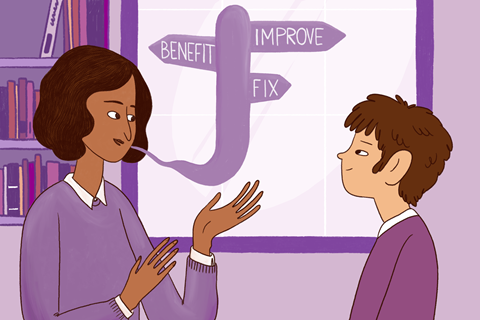Creating powerful feedback involves combining a focus on the here and now with an eye to the future
How will students benefit from our feedback? Answering this innocuous question should help us overcome three barriers to effective feedback, and increase the impact it has on our students.
Effective feedback changes students’ knowledge and future behaviour: this is easier to believe than it is to achieve. Most teacher feedback focuses on a specific task: we tell students where they’ve gone wrong, what to correct and how to improve. This makes sense: the immediate errors and limitations in students’ work elicit our feedback and this is where we want to see improvement. However, information we offer students “is considered as feedback only when it is used” to improve their work. We face three barriers meeting this exacting definition of feedback, and ensuring students benefit.

Barrier 1: Students don’t respond
Too often, students don’t apply (or don’t understand) our feedback. Just providing students information about how to improve is time-consuming and potentially fruitless: students must respond if they are to benefit. Some students may use feedback independently, but most need us to provide a specific activity, revising the current task or applying feedback to a new task.
Barrier 2: They don’t transfer specific feedback to new tasks
An improvement task is helpful, but if it only leads students to improve the current task, its benefits may be limited to that task. In the 2017 book, What does this look like in the classroom?, Dylan Wiliam notes that feedback should improve the learner, not the task: what matters is the student’s response when they next face a similar question. People struggle to apply knowledge to new problems without a hint, particularly for different problems and after some time. Our feedback may be immediately useful, but students may not think to use it next time it’s relevant: they may improve their atom diagram today, but fail to apply the same principles to another diagram, or a real-life example.
Barrier 3: They don’t apply general feedback to specific tasks
If we want students to improve beyond the current task, we could offer them general guidance, but they may not be able to apply it at all. We could tell them that scientists change only one variable at a time to measure its effect on a reaction, for example. This can be applied to every experiment students conduct: it should help them understand what is expected of them more deeply, but students often struggle to apply general ideas like this to specific tasks.
7 simple rules to boost science teaching
Click to expand and explore the rules
Build on the ideas that pupils bring to lessons
Help pupils direct their own learning
Use models to support understanding
Support pupils to retain and retrieve knowledge
- Pay attention to cognitive load—structure tasks to limit the amount of new information pupils need to process
- Revisit knowledge after a gap to help pupils retain it in their long-term memory
- Provide opportunities for pupils to retrieve the knowledge that they have previously learnt
- Encourage pupils to elaborate on what they have learnt
Use practical work purposefully and as part of a learning sequence
Develop scientific vocabulary and support pupils to read and write about science
Use structured feedback to move on pupils’ thinking
Overcoming the three barriers
The first barrier has a simple solution: provide students with an activity to apply feedback. The second and third are harder: both specific and generic feedback are limited. Recommendation 7b in the EEF’s Improving secondary science guidance, Think about what you’re providing feedback on, includes a table I developed to show the different levels of feedback we might offer, specific and generic. I’d advocate:
- Choosing levels of feedback to target – from improving the current task to improving understanding of the subject, or students’ self-regulation.
- Addressing barriers 2 and 3 by linking specific and general guidance: guidance at more than one level helps students improve the current task and future learning.
Our most powerful feedback combines an immediate focus and a broader implication. This might sound challenging, but it is achievable in a sentence: indeed, succinct, limited and clear feedback is crucial. ‘Refine your atomic model by … always remember to…’ may be enough, combined with a reminder the next time the topic arises. This feedback creates improvement that is both immediate and lasting.
This article is part of the series 7 simple rules for science teaching, developed in response to the EEF’s Improving secondary science guidance. It supports rule 7b, Think about what you're providing feedback on.
Downloads
Creating powerful feedback
Word, Size 61.72 kbCreating powerful feedback
PDF, Size 49.28 kb










No comments yet